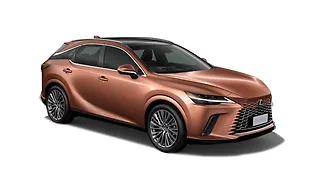What is it?

2017 marks the entry of Toyota’s luxury hand, Lexus in the Indian market. Looking at the premium pricing we already know, value for money is not something you will buy a Lexus for. The cheapest car in their line-up, the ES300h sedan costs more than Rs 70 lakh on-road, which means Lexus needs to bring something special to the party to trouble the well-established Germans.

As far as styling is concerned it definitely makes an impression and the signature Lexus spindle grille looks bold and the arrow-like LED daytime running lamps completes the premium front look. In profile the pronounced shoulder line, coupe-like roofline and well detailed multi-spoke alloys look elegant. At the rear the signature L-shaped taillights, an integrated spoiler and shapely bumper combine to give a well balanced look.
 \
\
The Lexus ES300h is based on Toyota’s K platform which also underpins the Camry. But the ES300h has its roots, more connected to Toyota’s full sized sedan the Avalon with whom it shares its longer 2820mm wheelbase with. As compared to its rivals like the Mercedes E-class and the Volvo S90, the Lexus sedan is smaller in every direction but on the flip side despite the hybrid system it weighs less too.
How is it on the inside?

Where the Lexus ES has a luxurious appearance on the outside, the story once you step inside isn’t as rosy. The curvy dash design definitely gets a big thumbs up from us, but it is in detail where the ES300h somewhat disappoints. Touch points like the steering, gear-lever, door handle and hand rest are all draped in rich hand stitched leather. But in most other places it is all covered in hard plastics and this is where ES300h’s price tag seems a bit too steep. The tacky buttons and knobs on the centre console particularly disappoint and the fonts on them shout 1980’s rather than 2017. Like you get an iDrive system in a BMW, Lexus has its own Remote Touch Interface which honestly is not the easiest to operate. Sure it becomes easier the more you use it but, the toggle remote (which functions like a computer mouse) next to the gear-lever is hyper sensitive and while driving over less than perfect roads, it isn’t easy to scroll through different menus.

The front seats on the Lexus E300h are spot-on with right amount of suppleness and they hold you in place quite well too. Back seat too has loads of space, but surprisingly it isn’t as good as the Camry’s seat which offers better thigh support and an adjustable backrest too. But on its own it is a pleasant place to be in and the integrated controls in the centre armrest for the rear AC and music system will definitely get a thumbs up from chauffer driven people. There are loads of storage option inside the cabin with several cup holders and a big glovebox. Surprisingly, there are no rear door pockets though. Boot space at just 425 litres is compromised due to the hybrid system’s battery stacked behind the rear seats. Yet the wide boot opening and flat-bay makes it very usable and as demonstrated by Lexus engineers to us, it can easily gulp four full-size golf bags.

The ES300h comes with loads of equipment like 10 airbags, ESP, LED headlamps, sunroof, powered front seats with memory, rear sunblind, cooled front seats, three-zone climate control, front and rear parking sensors and a reverse camera. You also get a fantastic sounding Mark Levinson sound system. The 15-speaker setup is really pleasing to the ear and even at high volume it never distorts and retains a flawless output. Apart from the long list of equipment you can also choose from loads of exterior and interior colour combinations in the ES300h will lend every customer an ambience of his choice.
How does it drive?

The Lexus ES300h uses the same powertrain as found under the hood of the Toyota Camry Hybrid. This hybrid system comprises of two electric motors, referred to as MG1 and MG2 by Lexus. The MG1 motor is an engine-driven power source for the batteries and also starts the internal-combustion engine after the batteries run out of juice. The MG2 unit on the other hand is used for propulsion during acceleration and switches into generator mode during periods of coasting or deceleration to provide regenerative braking. Combined with the 2.5-litre Atkinson cycle naturally aspirated motor, the Lexus ES300h generates a total of 202bhp.

You get four driving modes in the ES – EV, Eco, Normal and Sport. In EV mode, you drive on the electric motor alone and you’ve to be gentle on the throttle as you are restricted to a low 40kph and has a limited range of around 3km. Despite that it feels more than enough in crawling traffic and responses are smooth with no noise or vibration. If you want to go slightly faster, you have to engage Eco mode and here, the electric motor works well with the petrol engine and there’s enough power and torque on offer to make driving effortless, especially at the bottom end. The performance is quite nippy, but the moment you accelerate harder, the car takes a bit of time to get going as responses from the CVT gearbox are a bit spongy for maximum fuel efficiency. Normal mode feels the best as it retains ECO modes smooth nature and gives you more grunt as you go harder on the accelerator. In sport mode, things get even livelier and the large ES is a lot more fun to drive. Hit the accelerator pedal and you get an instant shove in the back, that keeps getting stronger for a few seconds and the ES300h moves forward with plenty of energy. In this mode, the electric motor assists the petrol motor even better but on the downside the throttle response becomes jerky.
But the biggest highlight of the Lexus ES300h is its refinement. The combination of a polished petrol motor, electric propulsion and outstanding sound insulation gives you a car that feels luxurious and this is where it has an edge over its rivals.

The laidback nature of the powertrain is well complimented by the pliant suspension in the ES. It is ideally suited to tackle potholes and patchy bits at slower speeds, absorbing the bumps with a nice, damped feeling and it works silently too. But sharper and bigger potholes do catch it out and the suspension tends to crash over them. The soft suspension means, keen driver will find the ES300h a bit too soft and heavy around corners. Grip is also limited as the fuel saving low resistance tyres squeal quite easily. But when driven in a relaxed manner the ES feels planted thanks to the fluid steering action and the safe and predictable handling characteristics. Braking despite the regenerative system is good with good pedal feel and good stopping power.
Should I buy one?

Let’s get one thing straight, the Lexus ES300h is not the best buy as far as product is concerned. Thanks to it being a CBU, where internationally it rivals the likes of Mercedes C-class in India it falls in the E-Class price bracket. On the positive side the Lexus ES300h feels special in its own right and it will definitely make for a unique and very satisfying ownership experience. With ever growing importance of low emission vehicles, the ES300h carves its own niche in a segment that is powered only by petrol or diesel motors. As of now Lexus has only four operational dealerships in India but when the need arises (breakdowns or accident) Lexus will make use of the strong Toyota network to make the ownership experience hassle free. Then there is the promise of reliability and low cost of ownership which is unheard of in a segment that is plagued by expensive aftersales experiences.
Where does it fit in?

The Lexus ES300h rivals the likes of Mercedes E-Class, BMW 5 Series, Audi A6, Volvo S90 and the Jaguar XF. Although the ex-showroom price-tag of Rs 55.27lakh sounds reasonable, being a CBU, RTO taxes are much higher and you have to shell out in excess of Rs 70 lakh to park the ES300h in your garage.
Pictures by: Kapil Angane

![Lexus ES [2017-2018] Exterior Lexus ES [2017-2018] Exterior](https://imgd.aeplcdn.com/642x361/cw/ec/29054/Lexus-ES-Exterior-96536.jpg?v=201711021421&wm=1&q=80)
![Lexus ES [2017-2018] Interior Lexus ES [2017-2018] Interior](https://imgd.aeplcdn.com/642x361/cw/ec/29054/Lexus-ES-Interior-96570.jpg?v=201711021421&wm=1&q=80)
![Lexus ES [2017-2018] Interior Lexus ES [2017-2018] Interior](https://imgd.aeplcdn.com/642x361/cw/ec/29054/Lexus-ES-Interior-96560.jpg?v=201711021421&wm=1&q=80)
![Lexus ES [2017-2018] Interior Lexus ES [2017-2018] Interior](https://imgd.aeplcdn.com/642x361/cw/ec/29054/Lexus-ES-Interior-96561.jpg?v=201711021421&wm=1&q=80)
![Lexus ES [2017-2018] Interior Lexus ES [2017-2018] Interior](https://imgd.aeplcdn.com/642x361/cw/ec/29054/Lexus-ES-Interior-96562.jpg?v=201711021421&wm=1&q=80)
![Lexus ES [2017-2018] Interior Lexus ES [2017-2018] Interior](https://imgd.aeplcdn.com/642x361/cw/ec/29054/Lexus-ES-Interior-96563.jpg?v=201711021421&wm=1&q=80)
![Lexus ES [2017-2018] Interior Lexus ES [2017-2018] Interior](https://imgd.aeplcdn.com/642x361/cw/ec/29054/Lexus-ES-Interior-96564.jpg?v=201711021421&wm=1&q=80)
![Lexus ES [2017-2018] Interior Lexus ES [2017-2018] Interior](https://imgd.aeplcdn.com/642x361/cw/ec/29054/Lexus-ES-Interior-96565.jpg?v=201711021421&wm=1&q=80)
![Lexus ES [2017-2018] Image Lexus ES [2017-2018] Image](https://imgd.aeplcdn.com/272x153/cw/ec/28343/Lexus-ES-Right-Front-Three-Quarter-93381.jpg?wm=0&q=80)
























